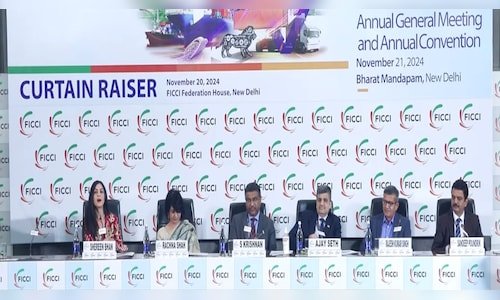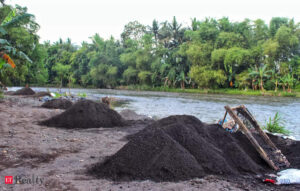Exclusive | India’s Road Ahead: Policymakers discuss growth, inflation & investments

The speakers, Ajay Seth, Secretary of Economic Affairs; Rajesh Kumar Singh, Secretary of Defence; S. Krishnan, Secretary of MeitY; Rachna Shah, Secretary of Textiles; and Sandeep Poundrik, Secretary of Steel, spoke during a panel discussion moderated by CNBC-TV18.
Among issues discussed were the Indian economy’s current situation, growth predictions, inflation worries, and spending plans on infrastructure. They noted the strength of different sectors despite global problems. The government supports local production in defence and seeks strong growth in textiles and steel. They also explained the role of foreign direct investment (FDI) and ways to grow local manufacturing skills. This creates a hopeful view for India’s economy, which aims to manage challenges and seize new chances.
Edited excerpt.
Q: What is your own assessment of the health and the strength of the Indian economy at this point in time? How concerned are you as far as inflation goes and what is the outlook now as far as interest rates go, given the fact that inflation is still running at 6%, above the RBI comfort level, what’s the expectation that the government has on both inflation as well as interest rates?
Seth: We started the year with estimates in the economic survey of 6.5% to 7% growth, and I see that we are still very much in that zone, and I don’t see any significant downside risk coming to that. What I see that several informed people have been talking about is whether there is any apparent slowdown. Yes, the numbers in the second quarter do show that some of the products or some of the services may not be at the same level where they were, say, about a year back, or even in, say, two quarters earlier.
But thereafter, if you look at some other indicators, especially, I’m looking at that in terms of the e-way bills or the e-invoices, especially in the month of October, they tell a different number.
That does not indicate that we have any significant possibility of any downside risk from 6.5% growth which has been estimated at the beginning of the year. Of course, whether it is going to be closer to 6.5% or it will be closer to 7%, I would not like to venture into that.
As far as inflation is concerned, yes, food prices have been a problem area, and this has been largely because of the extreme continuing rainfall, unusually long when it has continued this year. But other than the food prices, inflation is not a challenge.
As far as interest rates in the economy is concerned, I would rather not get into that. That is a monetary policy action, which, with the full information, the central bank will take a view on that.
Q: If I may ask about where things stand as far as capex is concerned, and there was a slowdown partly on account of the elections, but what’s the sense that you get today in terms of undershooting on the capex targets that the government has set out? And more importantly, do you expect a significant pick-up from here on?
Sheth: On that aspect, last year, the capital expenditure by the Government of India was ₹9.50 lakh crore. This year, it was budgeted about ₹11.1 lakh crore, and there may be some undershooting, but I do expect that will be a significant increase over last year. So, while some sectors are a bit slow, on the other hand, few other sectors there are additional demands coming up, so I don’t see that as a major issue coming up.
Even last year, it was budgeted for 10 expenditure was about 95%. So this year also we should be around the same percentage points.
Q: There’s been a lot of enthusiasm, as well as a lot of confidence, expressed with the Defence Ministry’s indigenisation list. We’ve seen five of those as far as the recent past is concerned, what should the expectation be from here on? And if you can give us a status check on where things currently stand in terms of the kind of cost savings we’ve accrued because of the import substitution done.
Singh: The defence industry in this country is at an inflection point. It’s reached a kind of a critical mass, where we now have significant volumes being produced indigenously. The value of production in this country has gone up by three times over the last 10 years or so, exports have gone up by 31 times, and our focus increasingly has been on ensuring that we spend our capex within this country. The ratio we originally set out three years back was about 60% to be spent within India and 40% outside. The ratio for the current year has now been enhanced further to 75%. We intend to double down on that indigenisation exercise that we are doing. In some ways, it’s a painful process because it is easier to simply buy things abroad, look at the brochures, take out the best set of capabilities that you want and try to get that. But in the long run, it detracts from your strategic autonomy. It detracts from your ability to withstand supply chain shocks, some of which we are actually facing today in the context of some of our systems. It’s not a secret that the S400 for example, is delayed. We’ve got three batteries, two more are delayed because of the conflicts that are ongoing.
So yeah, there is a strong strategic case for going indigenous, and we intend to double down there.
Our top priority will be on what we call IDDM, which is indigenously designed, developed and manufactured, that will be the sort of strand of our procurement process which we will focus on. And some of these are in areas where DRDO has developed technologies in artillery. You’ll probably see some cases where DRDO technology and private partners will come in, and we’ll be manufacturing that equipment at scale. The C295 model, where we have Airbus coming in along with the private sector partner, is another sort of, fairly strong sort of template, and we could probably do a few more of those.
In time, the intention is to increasingly bring in the private sector. Right now, in the domestic value that we produce, about 70% is by our 16 public sector undertakings, nine of which are new from the ordinance factories corporatised. Others are the older ones. The intention is increasingly to make it closer to 50-50, and I’m sure the private sector is going to step up in that direction. So yes, exciting times are ahead, and this is one sector where there will be a lot of expenditure happening about $20-$25 billion per year over the next 10 years. So certainly, this is an area where, if you’re there in this play, you will get a lot of growth.
Q: I want to understand from you what the outlook is as far as demand is concerned. Specifically, I want to address concerns that are being raised by the Indian industry. Sajjan Jindal, in a conversation with us, has very clearly said that there is a need for the government to impose higher tariffs and higher duties, especially on imports coming in from China. What is the government’s view? Do you believe that there is a legitimate case at this point in time to impose higher tariffs, and if that were to happen, what would be the impact and the implication on the consuming industry? Because you will have to find that balance.
Poundrik: I will start with the consumption side. Right now, the per capita consumption in India is approaching 100 kgs per person. If we see at the historical data, this is an inflection point as far as steel is concerned. And what has been seen is that as soon as countries reach about 100, their growth increases significantly. And that is already in the picture because in the first half of 2024-25, we have seen a growth of about 13% in steel consumption. So yes, on the demand side, I don’t see any problem.
In fact, if this growth continues again, I will refer to the finance secretary who mentioned about 10 lakh crore. So, with a government push in infrastructure, public demand, and public spending, we will need about 300 million tonnes of capacity by 2030, which is at present at 180 million tonnes of capacity. So that means 120 million tonnes of additional capacity, which means an approximate investment of $120 billion, which is ₹10 lakh crore.
If that investment has to come, then our industry has to have that kind of profitability that they are able to make that investment. Now, if that does not happen, then probably by 2030, we will become a net steel importer if our demand continues to rise and our production does not increase.
Coming to the issue of profitability, yes, there have been concerns in the last almost a year and especially in the last few months—six months—that dumping is happening at the international level, and steel prices have come down. In fact, the Indian imports for the first half of this financial year have increased by roughly 41%, and exports have gone down by 36%. So that’s a valid argument of the industry that steel prices are depressed. Inventory levels in steel companies have increased from 15-16 days to 30 days. So, there is a genuine problem, and we are aware of that.
So there are multiple ways of trying to protect the domestic industry, one of which is increasing the basic customs duty. The only problem is that 62% of our imports are from FTA countries. So if we increase basic customs duty, there is no impact on these 62% imports, because there is no duty.
The second option is safeguard duty, for which the industry will have to approach the DGTR, and they are, I think, preparing to do that. And third is anti-dumping, which again has a process. So that latter two have processes which the industry has to take on their own and approach the DGTR, the first one has its own limitations, because majority of imports will not be covered by BCD.
Q: Let me address the same issues with you: demand at this point in time across the sector has been strong. But do you believe that there is likely to be further momentum and a further build? Secondly, on FDI visibility, what are the expectations and the anticipation?
Krishnan: On the demand front, specifically on the electronics front, demand has been strong and continues to be strong. Concerns are really more on the software side, but even there, I think the nature of demand is pivoting, and more of it is going towards AI-driven services, more of it is going towards cyber security, and those areas, niche areas, as opposed to the way that it used to work before. But on the electronic side, clearly, the demand is strong, and again, we are also indigenising production more and more. The PLI schemes have really kicked in, so on the mobile side, which is almost about 40% of the electronics industry, we manufacture practically all the mobile phones that we need in the country today, and that’s a space where we should be really looking to target export demand. But with the PLI on IT Hardware kicking in, and many FICCI members also involved in that process, we really expect that domestic demand would be met comfortably with the kind of manufacture that takes place in India, in addition to what exports come in there.
The FDI pipeline continues to be strong. It’s one of the areas where we constantly keep getting inquiries. Of course, we are well aware of the semiconductor space, and the semiconductor space is now expanding to the ecosystem players who need to come in and in the regular electronics hardware manufacturing as well. There’s a fair amount of continuing interest, in various elements of components and also equipment manufacture. So, that is an ongoing pipeline which is going to be stronger.
Q: Let me address the demand issue with you, as well as the FDI issue with you, and ask you this in the backdrop of the challenges that Bangladesh is faced with because that has taken a significant share of global textile trade and the likelihood of some of that moving to India. What are your own expectations and assessment?
Shah: The demand in so far as the textile sector is concerned, presently, the size of the sector is about $170 billion, something like ₹14.35 lakh crore. The domestic demand is robust and growing. We have a large domestic market. And with an increase in disposable incomes, the textile sector is one which will certainly be seeing growth.
Our target is to increase the size of the sector from about $170 billion to $350 billion by 2030, and we are looking at a much larger share of the global export pie, as it were.
Presently, we are exporting something like $38-$40 billion textile products. And within the $350 billion of output, we are looking at $100 billion of export. So this means that the share, which is currently around 4% of the global export, we are looking at a much larger share of the pie.
The domestic demand has been fairly robust and should continue to be. It is the global trade in textiles for the last couple of years, two years, specifically after we had a historical high of exports in 2021-2022 when we touched $44 billion. And thereafter, two years have been slightly dull on account of certain geopolitical events and also on account of the inventory build-up in 2021-2022. But we are now seeing positive signs in terms of growth in the export sector as well. In the month-on-month estimates which have recently come out, especially in the apparel sector, we are seeing a growth of almost 35% and overall, for the textile sector a growth of 7%-8% compared to last year. So these are positive signs.
In the textile sector, India has a unique sort of position because we have the entire textile value chain present in the country, which is rare. Apart from a few other countries, it’s, it’s there in India – right from fibre to fabric to the entire processing chain, apparel, garments, technical, textile, and fashion. So I think we come with the position of strength that way. And I would like to think that further investment and export opportunities will come India’s way based on our own strength in the textile value chain.
The geopolitical events and events in Bangladesh would certainly have some bearing whether it would translate more perhaps in the medium to long term when our own capacities are also getting strengthened through some of the key initiatives that have been undertaken by the government so that we have more large scale and size of manufacturing and world-class textile infrastructure, which gets established. And some of the bigger brands, the international brands, are already working with us, but they are looking, perhaps, to increase their share over a period of time. So we do see these things happening as we go ahead.
So far as FDI is concerned, we are looking at huge investments coming into the textile sector. And while the domestic industry and the major players will certainly play a very important role in that, we certainly are looking at more and more international players coming into the textile sector as well. The FDI since 2000 has been something like $4.5 billion, so international players are there and they’re coming, but certainly, we are looking at a much larger share.
I think they are also looking at the domestic market, which is large and growing, and manufacturing in India for the domestic market and manufacturing in India for the export market is something that I’m sure is likely to attract foreign players.
Watch the accompanying video for the full discussion.








